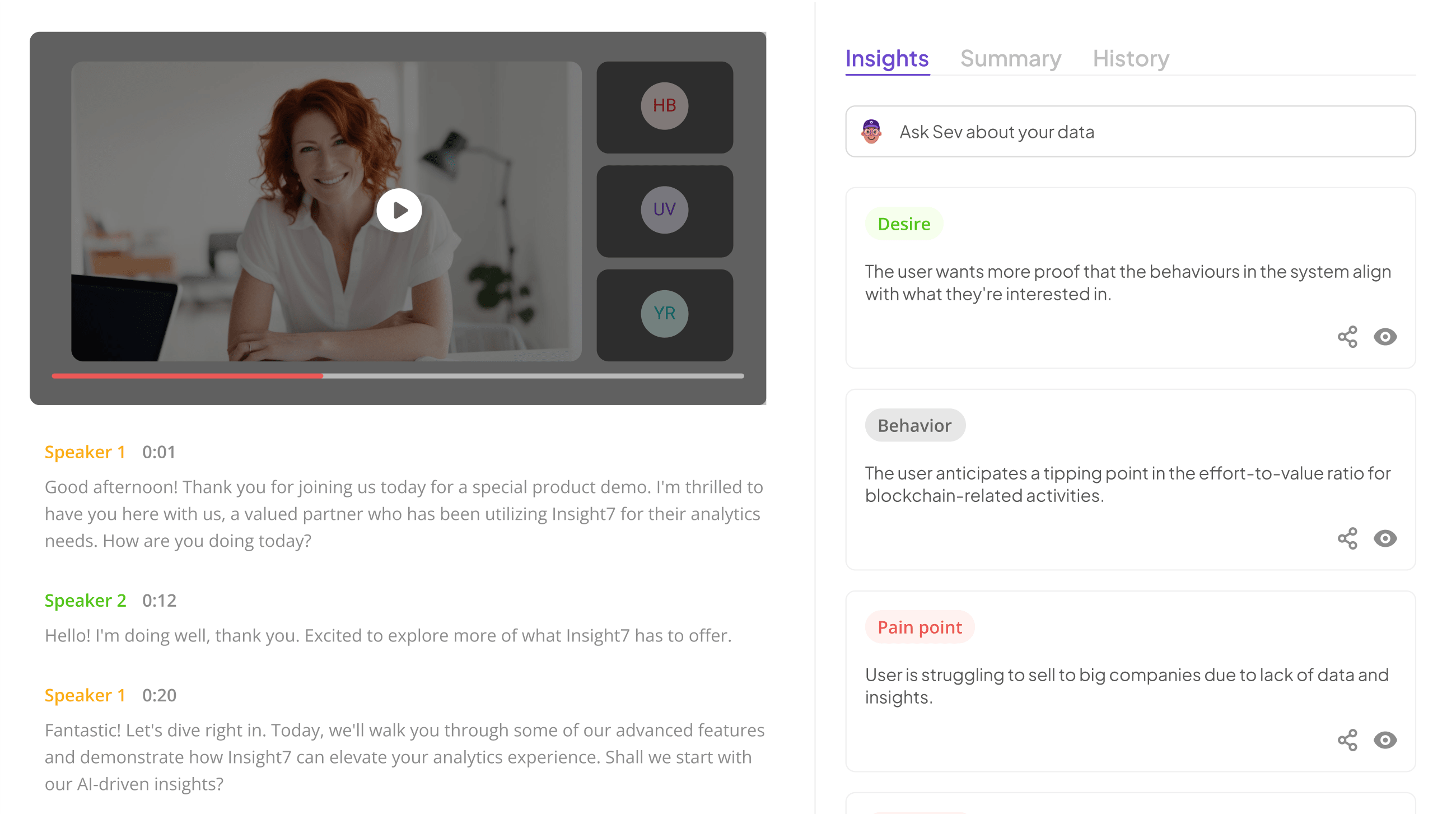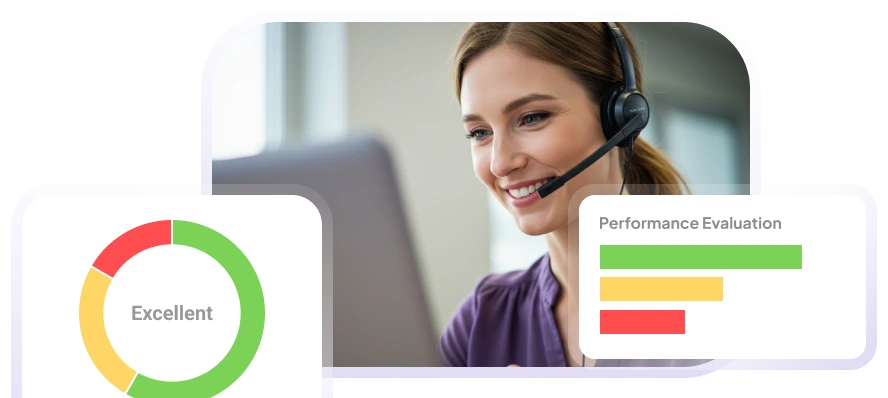Evaluating Sales Rep Adaptability During Pitch Adjustments
-
Bella Williams
- 10 min read
Pitch Flexibility Evaluation is essential in understanding how sales representatives adapt during pitch adjustments. Picture a skilled salesperson who can seamlessly transition their approach based on a prospect's reactions. This ability can determine the difference between closing a deal and losing a potential customer. Evaluating this flexibility is key to optimizing sales strategies and enhancing overall performance.
Sales representatives need to be agile and responsive, crafting pitches that align with the shifting dynamics of customer interactions. By assessing pitch flexibility, organizations can identify strengths and areas for improvement. This enables sales teams to adapt more effectively to client needs, ultimately driving better outcomes. Monitoring these patterns fosters a culture of continuous improvement and equips teams with the insights to refine their techniques.
Analyze & Evaluate Calls. At Scale.

Understanding the Importance of Pitch Flexibility Evaluation
Evaluating pitch flexibility is essential for understanding how well sales representatives adapt to changing circumstances during client interactions. Sales pitches are rarely one-size-fits-all; they require constant adjustments based on the client’s responses and needs. This adaptability not only demonstrates the sales rep's capacity to engage effectively but also builds trust and rapport, setting a solid foundation for a strong client relationship.
Key indicators of pitch flexibility include both verbal and non-verbal cues from clients. Observing these signals provides critical feedback that can inform real-time adjustments during conversations. Additionally, understanding how to interpret these cues helps sales professionals analyze and refine their approach, leading to enhanced performance. By focusing on this evaluation process, organizations can better equip their sales teams to respond to diverse client needs and keep pace with evolving market dynamics. This proactive approach ultimately strengthens the effectiveness of sales efforts and drives success in competitive environments.
Why Pitch Adjustments Are Crucial
Pitch adjustments are crucial for successful sales interactions. They allow sales representatives to meet varying customer needs and preferences, which can change frequently. By ensuring that pitches are not rigid, reps can significantly enhance engagement and foster trust. Adaptability in communication can lead to a deeper understanding of customer challenges, allowing representatives to tailor their messages to address specific pain points effectively.
Furthermore, pitch flexibility is essential in responding to market dynamics. As industry trends evolve, so do the expectations of potential clients. Sales reps who demonstrate the ability to adjust their approach can more readily align with these changes, making their offerings more relevant. This adaptability not only improves the likelihood of closing deals but also supports long-term customer relationships, creating a cycle of loyalty and repeat business that is vital for sustained success.
- Adapting to Customer Needs
Understanding customer needs is essential in the sales process, as it allows representatives to tailor their pitches effectively. When sales reps demonstrate adaptability, they can engage in meaningful dialogue that resonates with potential clients. This connection encourages customers to share insights about their unique challenges, enabling sales representatives to modify their approaches in real-time.
An effective strategy involves several key elements. First, asking open-ended questions can uncover deeper insights into the customer's concerns and priorities. Second, paying attention to verbal and non-verbal cues helps reps to gauge the customer's interest and adjust their presentation dynamically. Lastly, following up with tailored solutions or demonstrations fosters trust and strengthens relationships. Ultimately, analyzing these interactions through Pitch Flexibility Evaluation equips sales professionals to meet client expectations and enhance their overall success.
- Aligning with Market Changes
To effectively navigate market changes, sales representatives must possess the ability to adapt their pitches. Aligning with evolving market dynamics entails recognizing customer pain points and adjusting strategies accordingly. This alignment is crucial for ensuring relevance, particularly when new trends emerge that impact customer expectations and purchasing behavior. As sales pitches evolve, so must the representatives' understanding of these shifts.
Sales reps can enhance their adaptability by employing a framework that assesses market sentiment. This includes gathering real-time insights from customer interactions, which can inform pitch flexibility. By proactively responding to these insights, sales representatives not only cater to immediate customer needs but also position themselves as trusted advisors. Thus, continuous evaluation of pitch flexibility becomes an essential tool in aligning with market changes, ensuring that sales professionals remain responsive and effective in their outreach efforts.
Key Indicators for Pitch Flexibility
Sales representatives must exhibit various indicators of pitch flexibility to effectively navigate client interactions. Key indicators include verbal and non-verbal cues that reveal the representative's responsiveness to the client's needs. Additionally, real-time feedback adaptation allows the sales rep to modify their approach based on customer reactions, which is essential for building rapport and trust.
To further enhance Pitch Flexibility Evaluation, it is crucial to monitor aspects like pacing during conversations and the amount of time allocated to listening versus speaking. Sales reps who engage in active listening, demonstrate curiosity about client needs, and assertively address objections will typically achieve better outcomes. By understanding these indicators, sales teams can foster a more adaptive environment focused on continuous improvement, ultimately boosting overall sales performance.
- Verbal and Non-Verbal Cues
Verbal and non-verbal cues play a pivotal role in Pitch Flexibility Evaluation. These signals can significantly impact a sales rep's success during pitch adjustments. Sales representatives must be adept at reading their audience, interpreting both verbal feedback, such as tone and speech patterns, and non-verbal cues, including body language and facial expressions. Recognizing the nuances in customer reactions allows sales reps to modify their approach seamlessly.
To effectively evaluate adaptability, focus on three key aspects. First, active listening enhances understanding of customer concerns and motivations. Second, observing body language helps gauge the customer's engagement level, indicating when to adjust the pitch. Lastly, monitoring emotional responses provides insight into the customer's level of interest, allowing reps to pivot their strategies accordingly. By honing in on these verbal and non-verbal cues, sales representatives can boost their pitch effectiveness and drive better outcomes.
- Real-Time Feedback Adaptation
In the context of pitch flexibility evaluation, real-time feedback adaptation plays a crucial role. It allows sales representatives to adjust their approach dynamically based on client responses, fostering a more engaging dialogue. As sales calls progress, real-time feedback can highlight areas for immediate improvement, such as adjusting tone, pacing, or addressing objections that arise during the conversation. This ongoing evaluation leads to a deeper understanding of the client's needs and enhances the overall effectiveness of the sales pitch.
To effectively implement real-time feedback adaptation, consider the following key aspects: first, incorporate active listening techniques to ensure genuine engagement with the client. Secondly, utilize technology like conversation analytics tools to analyze verbal and non-verbal cues during sales interactions. Finally, promote a culture of continuous improvement where feedback is regularly shared among team members. Together, these practices not only enhance pitch flexibility evaluation but also contribute to building stronger client relationships.
Extract insights from interviews, calls, surveys and reviews for insights in minutes
Tools and Techniques for Pitch Flexibility Evaluation
To evaluate pitch flexibility effectively, leveraging a range of tools and techniques is essential. Analyzing sales calls requires a systematic approach that combines qualitative observations and quantitative data. The primary aim is to create a framework that offers insights into a sales representative's adaptability during pitch adjustments.
Leading tools such as Insight7, Gong, and Chorus provide robust platforms for analyzing conversation dynamics. These tools can highlight critical elements such as key phrases, interruptions, and the pacing of discussions. By utilizing conversation analytics, sales managers can assess whether representatives are engaging effectively with clients and identifying their needs. Furthermore, implementing structured metrics for evaluation ensures that the adaptability of sales pitches is measurable and concrete.
A step-by-step evaluation process can enhance this analysis. First, establish baseline metrics to gauge performance. Next, implement chosen evaluation tools for data gathering. Analyze the adaptability patterns observed, allowing for targeted improvement strategies. Finally, fostering a culture of continuous improvement empowers sales teams to refine their pitches based on real-time feedback and performance data, ensuring long-term success.
Leading Tools for Evaluating Adaptability
Evaluating adaptability through effective tools is essential for sales reps during pitch adjustments. One method includes utilizing AI-driven platforms such as Insight7. This tool leverages advanced analytics to assess verbal and non-verbal cues, providing sales teams with valuable insights. Another option is Gong, which offers conversation analytics that can highlight trends and patterns, helping to identify successful pitch alterations.
Chorus also plays a vital role by enabling AI-assisted analysis of sales calls, giving a deeper understanding of customer interactions. Additionally, real-time meeting platforms like Zoom can track adaptability during discussions, helping reps modify their approach based on instant feedback. By integrating these tools, organizations can effectively measure pitch flexibility evaluation and enhance their sales strategies. This holistic approach fosters continuous improvement, ultimately leading to better engagement with prospects and increased sales performance.
- insight7: AI-driven sales adaptability analysis
AI-driven sales adaptability analysis plays a pivotal role in evaluating sales rep adaptability during pitch adjustments. This analysis employs advanced algorithms and machine learning to assess how well sales professionals respond to varying client needs during conversations. It examines not just what is being said but also how it’s presented, making it essential for understanding pitch flexibility evaluation.
To perform a comprehensive adaptability analysis, key factors are considered: verbal responsiveness, probing questions, and active listening techniques. Evaluating these elements helps identify areas where sales reps excel or struggle in their pitch delivery. By incorporating tools such as insight7, Gong, or Chorus, sales organizations can quantitatively analyze performance metrics, track client engagement, and adjust pitches dynamically based on real-time feedback. This iterative process ultimately nurtures a culture of continuous improvement, setting the stage for more successful sales engagements.
- Gong: Conversation analytics and insights
Conversation analytics play a crucial role in evaluating sales rep adaptability, particularly when considering how pitches can be adjusted in real-time. By analyzing recorded conversations, teams can uncover valuable insights into the effectiveness of their pitch strategies. This analysis is not just about tracking performance; it helps identify key moments where reps successfully engaged prospects or possibly missed opportunities. Utilizing conversation analytics tools allows for a detailed examination of verbal and non-verbal cues, promoting a more comprehensive understanding of each sales interaction.
Incorporating conversation analytics into your Pitch Flexibility Evaluation process can significantly enhance performance. Key insights drawn from conversations facilitate understanding your prospects’ needs and reactions, ultimately shaping your sales approach. By focusing on these analytics, sales teams can pinpoint areas for improvement, develop better questioning techniques, and adapt their pitches accordingly. This data-driven approach ensures that reps are not just following a script but are genuinely connecting with prospects, paving the way for more effective and flexible sales conversations.
- Chorus: AI-assisted call analysis
AI-assisted call analysis, like the functionality provided by Chorus, has revolutionized the way sales reps adapt during pitch adjustments. This innovative technology allows businesses to assess their sales calls with precision, focusing on verbal and non-verbal cues that indicate flexibility. By analyzing interactions in detail, sales teams can gain insights into how well representatives adjust their approach based on client responses. This process is vital for understanding pitch flexibility evaluation.
The application of AI in call analysis offers several benefits. Firstly, it provides immediate feedback, enabling reps to make real-time adjustments during the call. Secondly, detailed analytics help identify patterns in communication styles, allowing for tailored coaching and improvement strategies. Lastly, these insights foster a culture of adaptability, which is essential for closing deals effectively. Embracing AI-assisted tools like Chorus facilitates a shift from gut-based evaluations to objective, data-driven decisions, ultimately enhancing sales performance.
- Zoom: Real-time meeting adaptability tracking
Zoom serves as an indispensable tool for real-time meeting adaptability tracking, providing essential data that enhances pitch flexibility evaluation. In an era where sales dynamics are ever-changing, the ability to adapt during a call is vital. Zoom facilitates this by capturing verbal cues, tone shifts, and body language, allowing sellers to adjust their strategies instantaneously. Sales representatives can harness these insights to pivot their pitches effectively based on the prospect's reactions.
Moreover, the incorporation of feedback loops within Zoom meetings offers an opportunity for immediate reassessment. For instance, if a sales rep notices disengagement from the prospect, they can modify their approach in real time, showcasing adaptability. By leveraging Zoom's features, teams can strengthen their adaptability evaluations, ultimately enhancing sales performance and client satisfaction. Embracing such tools allows organizations to ensure their sales reps are well-equipped to meet the demands of prospective clients, making adaptability a cornerstone of successful pitching strategies.
Step-by-Step Evaluation Process
The Step-by-Step Evaluation Process is essential for accurately assessing a sales representative's adaptability during pitch adjustments. This structured approach ensures that evaluations are objective and data-driven, allowing for actionable insights. First, establish baseline metrics to understand what effective sales interactions look like. This serves as the foundation upon which evaluations can be built.
Next, implement evaluation tools that provide real-time data and feedback, such as Gong and Insight7. These platforms can track verbal and non-verbal cues, offering insights into how sales pitches align with client needs. Once the data is collected, analyze adaptability patterns for recurring themes and areas for improvement. Lastly, fostering a culture of continuous improvement is vital. Provide feedback loops to sales reps, helping them refine their approach and ultimately improve their pitch flexibility. This systematic process not only enhances sales performance but also positions sales representatives to better meet evolving customer needs.
- Step 1: Establish Baseline Metrics
To effectively evaluate a sales rep's adaptability during pitch adjustments, establishing baseline metrics is critical. This foundational step involves gathering data on current performance, identifying key indicators, and determining specific areas for improvement. By developing clear metrics, organizations can maintain an objective framework that moves away from subjective, gut-based evaluations. With concrete benchmarks, both management and sales reps can better understand where adaptability can be improved.
One effective approach involves collecting historical sales data to identify patterns regarding successful and unsuccessful pitches. Additionally, analyzing key interactions during calls, such as client responses and engagement levels, can highlight areas requiring attention. This initial assessment helps guide the overall Pitch Flexibility Evaluation, ultimately informing adjustments and setting measurable goals for ongoing improvement. Building a structured analysis framework ensures that evaluations are comprehensive, focused, and ultimately productive in enhancing sales performance.
- Step 2: Implement Evaluation Tools
To ensure successful pitch adjustments, the implementation of robust evaluation tools is paramount. These tools facilitate a systematic approach to assessing sales representatives' adaptability during calls. By establishing concrete metrics, managers can gain valuable insights into how flexibly a rep adjusts their pitch based on real-time customer feedback and engagement levels.
Integrating tools such as Gong and Chorus into your evaluation process further strengthens the Pitch Flexibility Evaluation. These platforms analyze conversations, allowing for the identification of key patterns in adaptability. It’s essential to monitor verbal and non-verbal cues, as well as the ability to pivot based on client reactions. Such data-driven insights not only reveal areas for improvement but also foster a culture of continuous learning within the sales team, ultimately enhancing overall performance and client relationships.
- Step 3: Analyze Adaptability Patterns
To effectively evaluate sales representatives' adaptability during pitch adjustments, it is crucial to analyze adaptability patterns. This step allows you to assess how well sales reps can modify their approach based on the evolving dynamics of a conversation. Identifying these patterns reveals not only strengths but also areas that may require further development.
Look for specific indicators of adaptability, such as changes in tone, pacing, and content during pitches. By tracking these verbal and non-verbal cues, you can determine whether a sales rep is responding effectively to customer feedback and their unique challenges. Consistent observation and analysis lead to better insights into each representative's adaptability skills, enhancing your understanding of their overall performance in real-time scenarios. This Pitch Flexibility Evaluation will ultimately provide a comprehensive perspective on adaptability patterns that drive successful sales outcomes.
- Step 4: Foster Continuous Improvement
Fostering continuous improvement is essential for evaluating pitch flexibility among sales representatives. By creating an environment that encourages learning and adaptation, organizations can enhance their sales team's effectiveness. Continuous improvement involves regular feedback and coaching to help reps refine their pitches based on real-time customer interactions.
To implement this, start by establishing a feedback loop where sales reps can share insights from their pitches. This practice allows them to identify what worked and what didn’t. Additionally, integrating technology, such as AI-powered tools for sales adaptability analysis, can provide valuable data on pitch performance. Regular team reviews can help in discussing adaptations and inspire new strategies, ensuring that reps remain agile and responsive to market needs. Emphasizing growth will not only boost individual performance but also drive overall sales success through effective pitch flexibility evaluation.
Conclusion: The Impact of Effective Pitch Flexibility Evaluation on Sales Performance
Effective pitch flexibility evaluation plays a pivotal role in enhancing sales performance. By systematically assessing how sales representatives adjust their pitches based on client responses, organizations can identify patterns that contribute to successful engagements. This adaptability allows sales reps to connect more meaningfully with prospects, ultimately increasing the likelihood of closing deals.
Moreover, focusing on objective evaluation metrics fosters a culture of growth and learning among sales teams. When sales professionals are trained to recognize verbal and non-verbal cues, they become more adept at responding dynamically to client needs. Such thorough evaluations not only elevate individual capabilities but also significantly improve overall team performance. Investing in pitch flexibility evaluation tools is essential for sustainable sales success.







